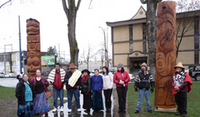First Nations presence
Red Cedar: Tree of Life
The cedar tree is central to Coastal First Nations' traditional and ceremonial life. Every part of the tree is a resource for clothing, utensils, pole carving, and ceremonial objects, and the tree plays an integral role in first Nations' spiritual beliefs. As such, the cedar tree was a key element in the commemoration of the First Nations' presence in the park.
After consulting with Kat Norris, a Downtown Eastside and Indigenous advocate from the Lyackson, Coast Salish First Nations on ceremonial protocol, the First Nations' sub-committee hosted a traditional ceremonial planting of a Western Red Cedar in the park on 12 April 2011. The ceremony was conducted by Robert Nahanee, a respected Coast Salish Cultural Advisor of the Squamish Nation, with the support and celebration of the community.
Partners and sponsors
- Oppenheimer Park commemorative Task Force
- Vancouver Board of Parks and Recreation
Carvings
Carving traditions are established social and cultural legacies of the Coastal First Nations. They are also the contemporary arts practice of highly respected First Nations' carvers. An important community celebration marked the installation of two new carvings in the park on 16 February 2012. The Oppenheimer Park Commemorative Task Force partnered with the Constant Arts Society and Vancouver Moving Theatre / Heart of the City Festival to create and install the carvings in the park on the northeast side of the new field house.
Head carvers Chief Henry Robertson (Haisla Nation) and Wes Nahanee (Squamish Nation) designed and carved the logs, which had been recovered from Stanley Park after the 2006 wind storm. Over several months, community members watched and sometimes participated as the carvers transformed the logs into carvings that reflect different Coast Salish traditions and honour the diverse First Nations' presence in the neighbourhood.
The carvings were blessed on 6 November 2010 during the Heart of the City Festival with a ceremonial moving of the poles, music, dancing, a feast, and the Canada Council award presentation to Christine Germano (Artistic Director of Constant Arts Society) for her work with First Nations.
A community celebration marked the installation of the two carvings on the east site of the field house in the park on 16 February 2012.
Partners
Sponsors
- Canada Council for the Arts
- Cultural Connections for Aboriginal Youth
- City of Vancouver, Great Beginnings
- Vancouver Board of Parks and Recreation
 Oppenheimer Park Commemorative Project
Oppenheimer Park Commemorative Project




 On 19 September 2011 the new legacy Sakura Windows were installed in the park field house with a haiku poem and text that explains the significance of the trees, visible on the northeast side of the building.
On 19 September 2011 the new legacy Sakura Windows were installed in the park field house with a haiku poem and text that explains the significance of the trees, visible on the northeast side of the building.  The Japanese Canadian community living around Oppenheimer Park, originally known as Powell Street Grounds, established the Asahi baseball club by 1914. Before disbanding in 1941, the Asahi won multiple championships in Vancouver’s senior amateur and industrial leagues, and in the eleven Pacific Northwest Japanese Baseball tournaments held in Seattle between 1928 and 1941.
The Japanese Canadian community living around Oppenheimer Park, originally known as Powell Street Grounds, established the Asahi baseball club by 1914. Before disbanding in 1941, the Asahi won multiple championships in Vancouver’s senior amateur and industrial leagues, and in the eleven Pacific Northwest Japanese Baseball tournaments held in Seattle between 1928 and 1941.